2021 VOLKSWAGEN TRANSPORTER wheel
[x] Cancel search: wheelPage 416 of 486
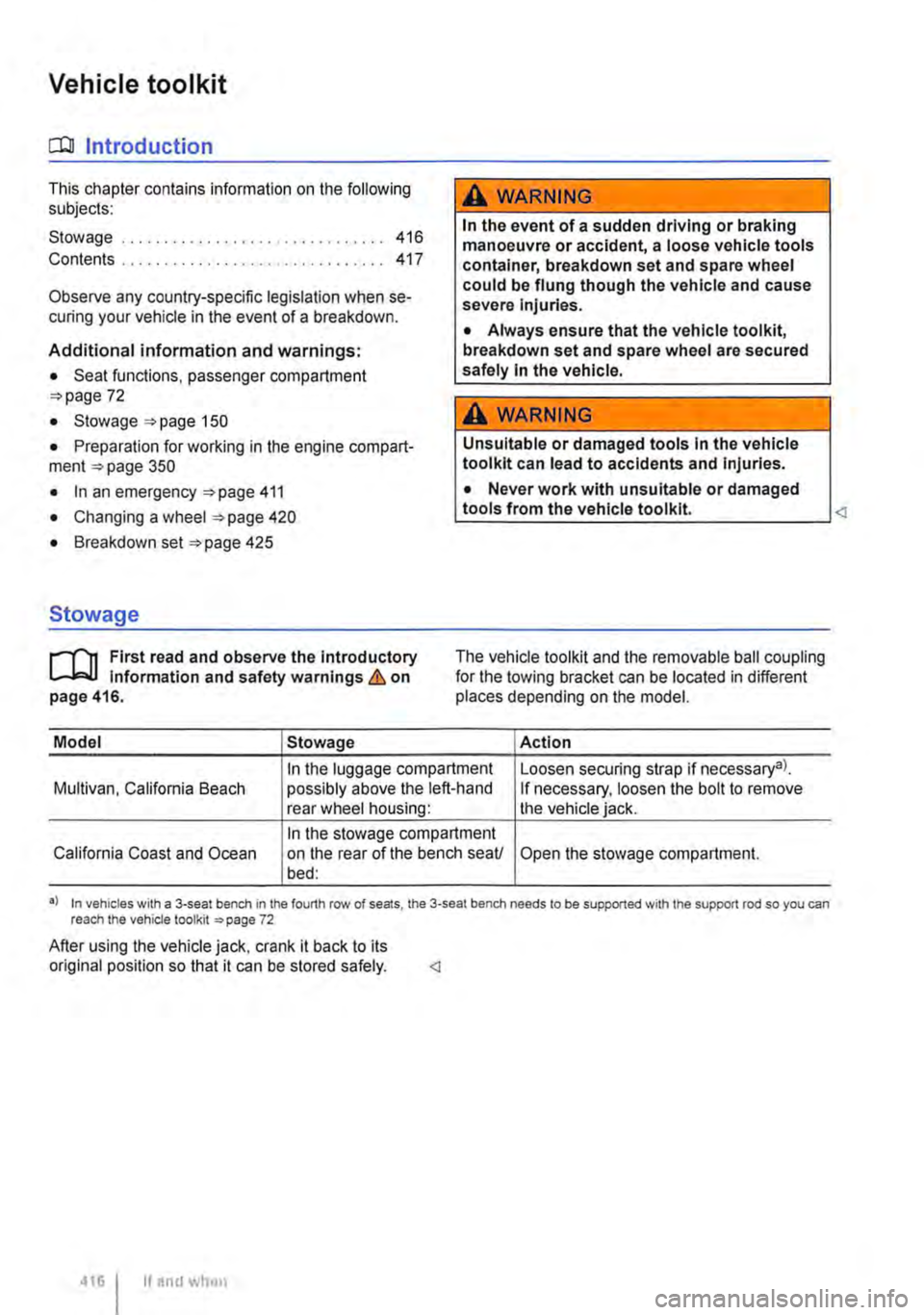
Vehicle toolkit
CCll Introduction
This chapter contains information on the following subjects:
Stowage Contents 416 417
Observe any country-specific legislation when se-curing your vehicle in the event of a breakdown.
Additional information and warnings:
• Seat functions, passenger compartment 72
• Stowage =>page 150
• Preparation for working in the engine compart-ment page 350
• In an emergency =>page 411
• Changing a wheel 420
• Breakdown set =>page 425
Stowage
r-111 First read and observe the introductory L-J,::.U information and safety warnings & on page 416.
Model Stowage
A WARNING
In the event of a sudden driving or braking manoeuvre or accident, a loose vehicle tools container, breakdown set and spare wheel could be flung though the vehicle and cause severe injuries.
• Always ensure that the vehicle toolkit, breakdown set and spare wheel are secured safely in the vehicle.
A WARNING
Unsuitable or damaged tools in the vehicle tool kit can lead to accidents and injuries.
• Never work with unsuitable or damaged tools from the vehicle toolklt.
Action
In the luggage compartment Loosen securing strap if necessarya)_ Multivan, California Beach possibly above the left-hand If necessary, loosen the bolt to remove rear wheel housing: the vehicle jack.
In the stowage compartment California Coast and Ocean on the rear of the bench sea V Open the stowage compartment. bed:
•I In vehicles with a 3-seat bench in the fourth row of seats, the 3-seat bench needs to be supported with the support rod so you can reach the vehicle toolkit , page 72
After using the vehicle jack, crank it back to its original position so that it can be stored safely.
Page 417 of 486
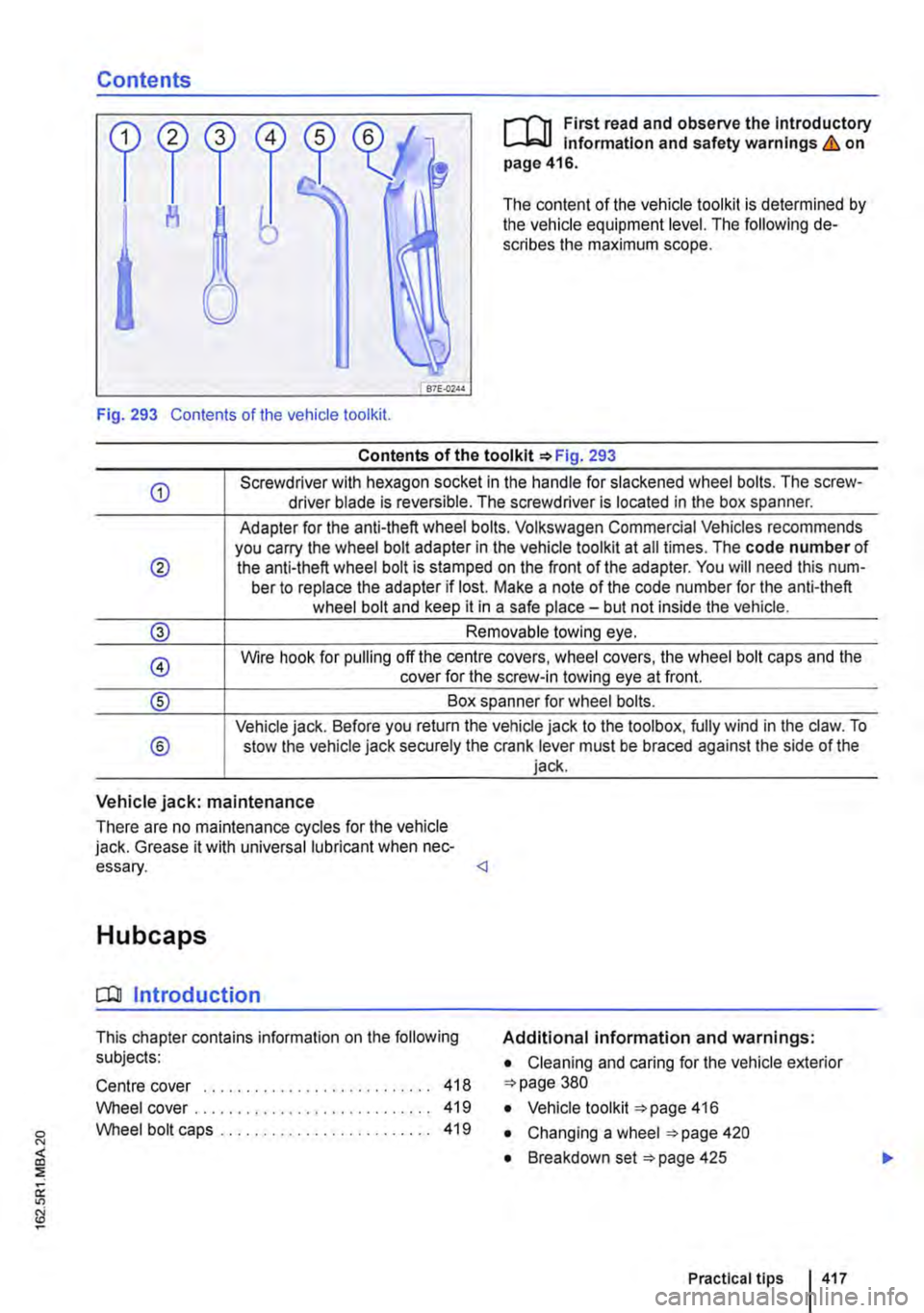
Contents
,...-'('n First read and observe the introductory L-J,:,JJ Information and safety warnings & on page 416.
The content of the vehicle tool kit is determined by the vehicle equipment level. The following de-scribes the maximum scope.
Fig. 293 Contents of the vehicle tool kit.
®
®
Contents of the tool kit =>Fig. 293
Screwdriver with hexagon socket in the handle for slackened wheel bolts. The screw-driver blade is reversible. The screwdriver is located in the box spanner.
Adapter for the anti-theft wheel bolts. Volkswagen Commercial Vehicles recommends you carry the wheel bolt adapter in the vehicle tool kit at all times. The code number of the anti-theft wheel bolt is stamped on the front of the adapter. You will need this num-ber to replace the adapter if lost. Make a note of the code number for the anti-theft wheel bolt and keep it in a safe place-but not inside the vehicle.
Removable towing eye.
Wire hook for pulling off the centre covers, wheel covers, the wheel bolt caps and the cover for the screw-in towing eye at front.
Box spanner for wheel bolts.
Vehicle jack. Before you return the vehicle jack to the tool box, fully wind in the claw. To stow the vehicle jack securely the crank lever must be braced against the side of the jack.
Vehicle jack: maintenance
There are no maintenance cycles for the vehicle jack. Grease it with universal lubricant when nec-essary.
COl Introduction
This chapter contains information on the following subjects:
Centre cover ... .
Wheel cover .. . Wheel bolt caps ..
418 419 419
Additional information and warnings:
• Cleaning and caring for the vehicle exterior =>page 380
• Vehicle tool kit =>page 416
• Changing a wheel =>page 420
• Breakdown set =>page 425
Practical tips I 417
Page 418 of 486
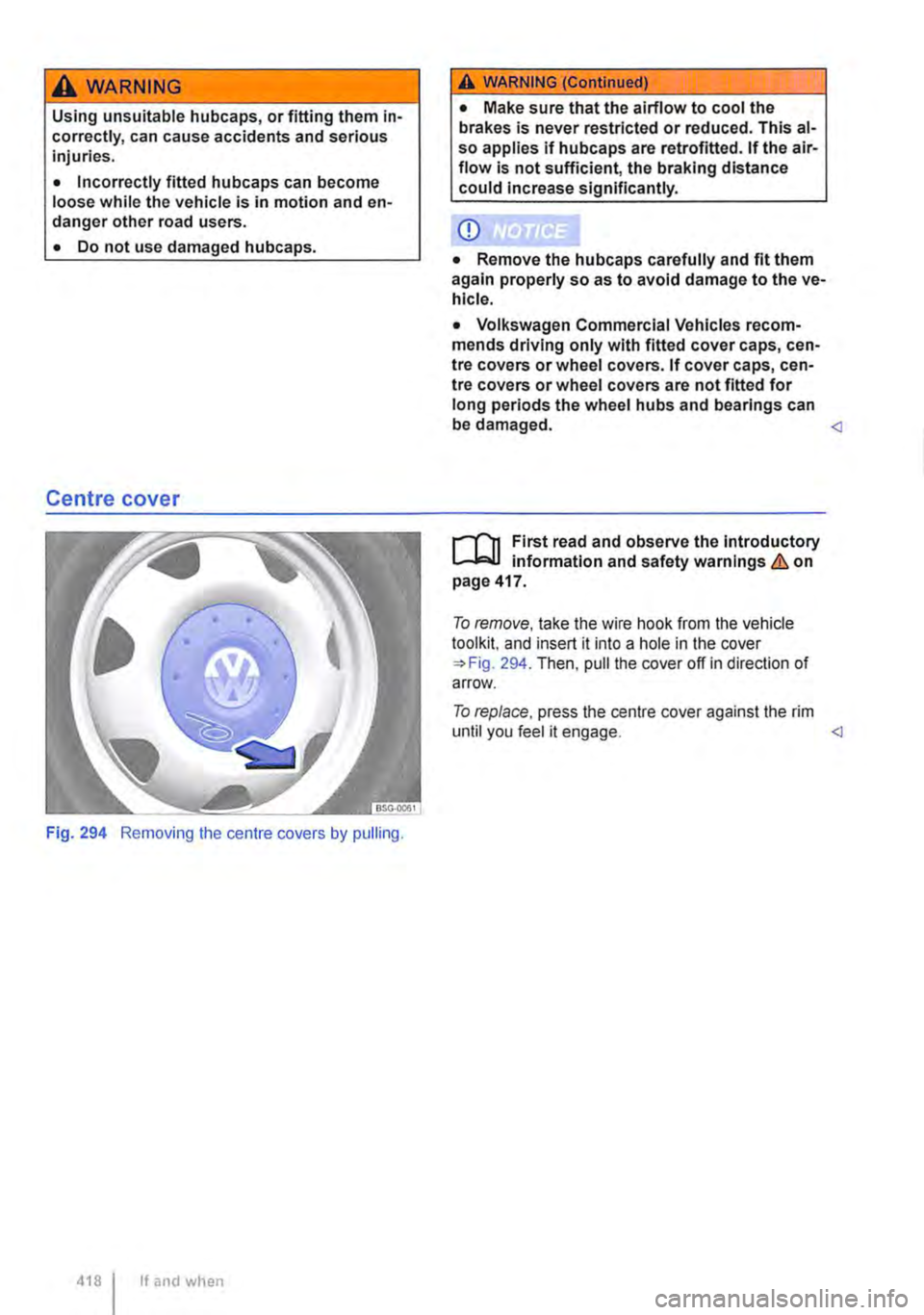
A WARNING
Using unsuitable hubcaps, or fitting them in-correctly, can cause accidents and serious injuries.
• Incorrectly fitted hubcaps can become loose while the vehicle is in motion and en-danger other road users.
• Do not use damaged hubcaps.
Centre cover
Fig. 294 Removing the centre covers by pulling.
418 I If and when
A WARNING (Continued)
• Make sure that the airflow to cool the brakes is never restricted or reduced. This al-so applies if hubcaps are retrofitted. If the air-flow is not sufficient, the braking distance could Increase significantly.
CD
• Remove the hubcaps carefully and fit them again properly so as to avoid damage to the ve-hicle.
• Volkswagen Commercial Vehicles recom-mends driving only with fitted cover caps, cen-tre covers or wheel covers. If cover caps, cen-tre covers or wheel covers are not fitted for long periods the wheel hubs and bearings can be damaged. <1
l"'""f'n First read and observe the introductory L-l=JI information and safety warnings & on page 417.
To remove, take the wire hook from the vehicle tool kit. and insert it into a hole in the cover =>Fig. 294. Then, pull the cover off in direction of arrow.
To replace, press the centre cover against the rim until you feel it engage.
Page 419 of 486
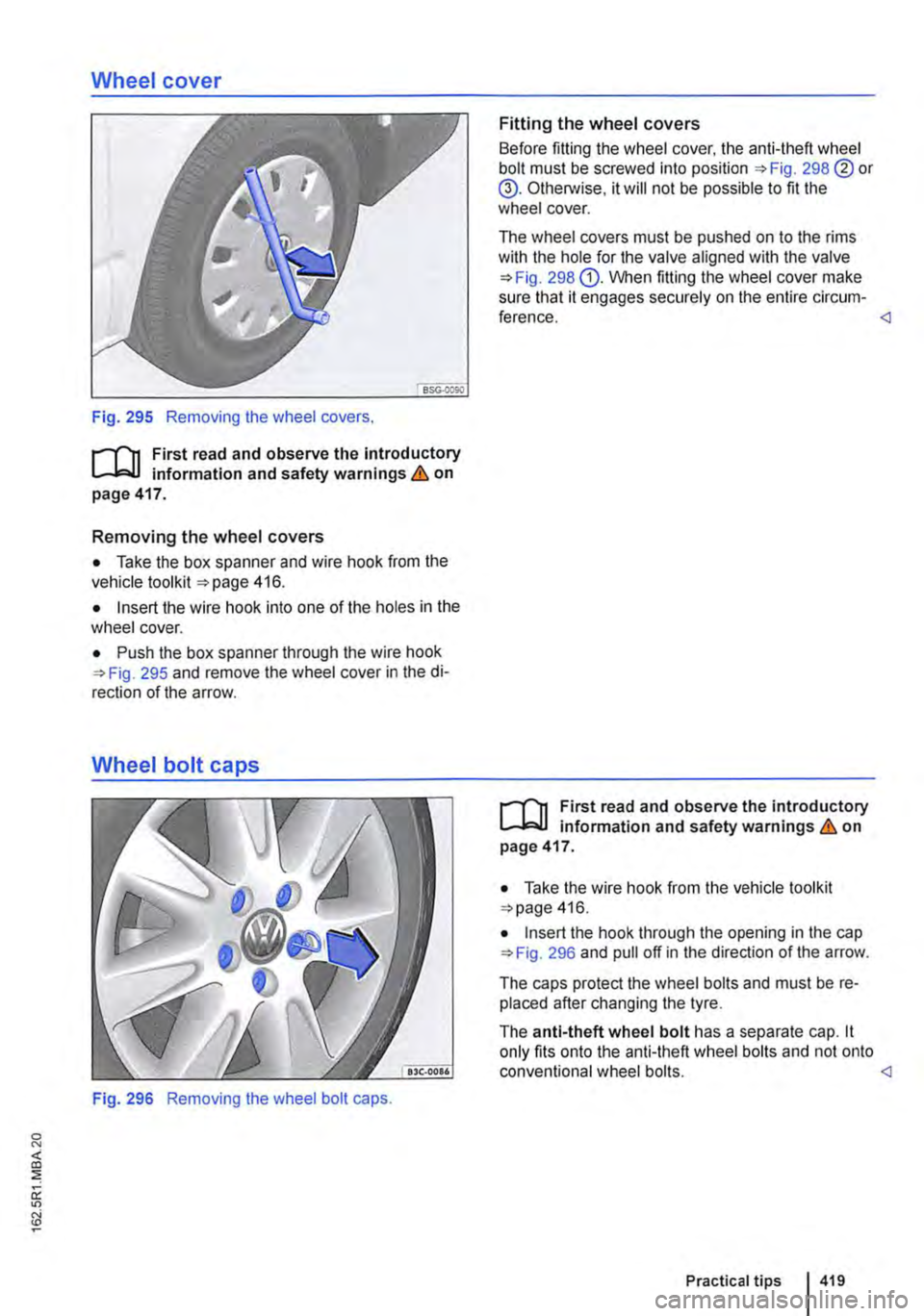
Wheel cover
Fig. 295 Removing the wheel covers.
r-f"n First read and observe the Introductory information and safety warnings & on page 417.
Removing the wheel covers
• Take the box spanner and wire hook from the vehicle toolkit 416.
• Insert the wire hook into one of the holes in the wheel cover.
• Push the box spanner through the wire hook 295 and remove the wheel cover in the di-rection of the arrow.
Fig. 296 Removing the wheel bolt caps.
Fitting the wheel covers
Before fitting the wheel cover, the anti-theft wheel bolt must be screwed into position 298 ®or @. Otherwise, it will not be possible to fit the wheel cover.
The wheel covers must be pushed on to the rims with the hole for the valve aligned with the valve 298 G). When fitting the wheel cover make sure that it engages securely on the entire circum-ference.
• Take the wire hook from the vehicle tool kit 416.
• Insert the hook through the opening in the cap 296 and pull off in the direction of the arrow.
The caps protect the wheel bolts and must be re-placed after changing the tyre.
The anti-theft wheel bolt has a separate cap. it only fits onto the anti-theft wheel bolts and not onto conventional wheel bolts.
Page 420 of 486
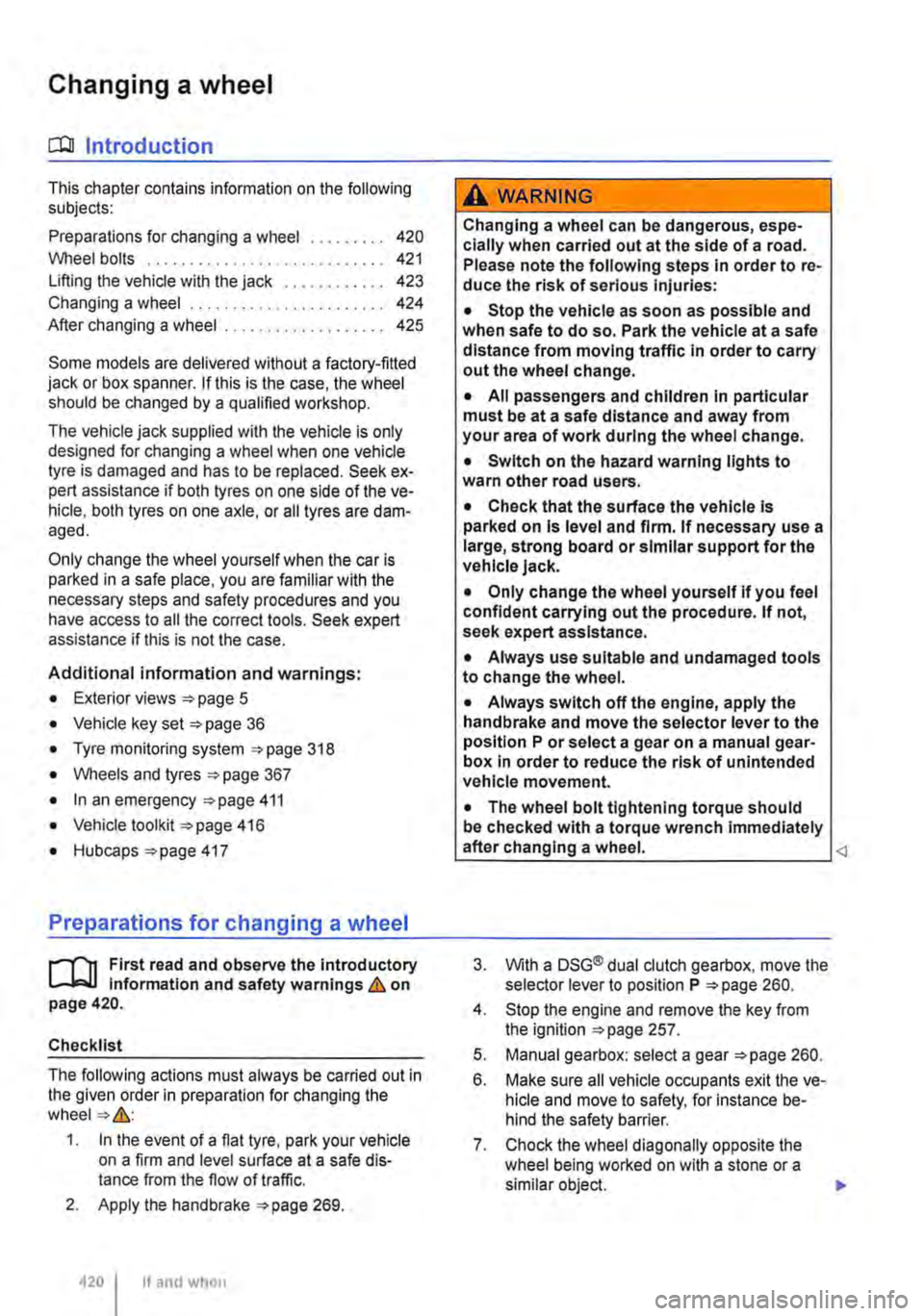
Changing a wheel
CllJ Introduction
This chapter contains information on the following subjects:
Preparations for changing a wheel . . . . . . . . . 420
Wheel bolts . . . . . . . . . . . . . . . . . . . 421
Lifting the vehicle with the jack . . . . . . . . . . . . 423
Changing a wheel . . . . . . . . . . . . . . . . . . . . . . . 424
After changing a wheel . . . . . . . . . . . . . 425
Some models are delivered without a factory-fitted jack or box spanner. If this is the case, the wheel should be changed by a qualified workshop.
The vehicle jack supplied with the vehicle is only designed for changing a wheel when one vehicle tyre is damaged and has to be replaced. Seek ex-pert assistance if both tyres on one side of the ve-hicle, both tyres on one axle, or all tyres are dam-aged.
Only change the wheel yourself when the car is parked in a safe place, you are familiar with the necessary steps and safety procedures and you have access to all the correct tools. Seek expert assistance if this is not the case.
Additional information and warnings:
• Exterior views =>page 5
• Vehicle key set =>page 36
• Tyre monitoring system =>page 318
• Wheels and tyres =>page 367
• In an emergency =>page 411
• Vehicle tool kit =>page 416
• Hubcaps =>page 417
Preparations for changing a wheel
1"1'11 First read and observe the introductory L-1o:.U information and safety warnings & on page 420.
Checklist
The following actions must always be carried out in the given order in preparation for changing the wheel=>&:
1. In the event of a flat tyre, park your vehicle on a firm and level surface at a safe dis-tance from the flow of traffic.
2. Apply the handbrake =>page 269.
420 I If and when
A wARNING
Changing a wheel can be dangerous, espe-cially when carried out at the side of a road. Please note the following steps in order to re-duce the risk of serious injuries:
• Stop the vehicle as soon as possible and when safe to do so. Park the vehicle at a safe distance from moving traffic in order to carry out the wheel change.
• All passengers and children in particular must be at a safe distance and away from your area of work during the wheel change.
• Switch on the hazard warning lights to warn other road users.
• Check that the surface the vehicle Is parked on Is level and firm. If necessary use a large, strong board or similar support for the vehicle jack.
• Only change the wheel yourself if you feel confident carrying out the procedure. If not, seek expert assistance.
• Always use suitable and undamaged tools to change the wheel.
• Always switch off the engine, apply the handbrake and move the selector lever to the position P or select a gear on a manual gear-box in order to reduce the risk of unintended vehicle movement.
• The wheel bolt tightening torque should be checked with a torque wrench immediately after changing a wheel.
4. Stop the engine and remove the key from the ignition =>page 257.
5. Manual gearbox: select a gear =>page 260.
6. Make sure all vehicle occupants exit the ve-hicle and move to safety, for instance be-hind the safety barrier.
7. Chock the wheel diagonally opposite the wheel being worked on with a stone or a similar object. ""
Page 421 of 486
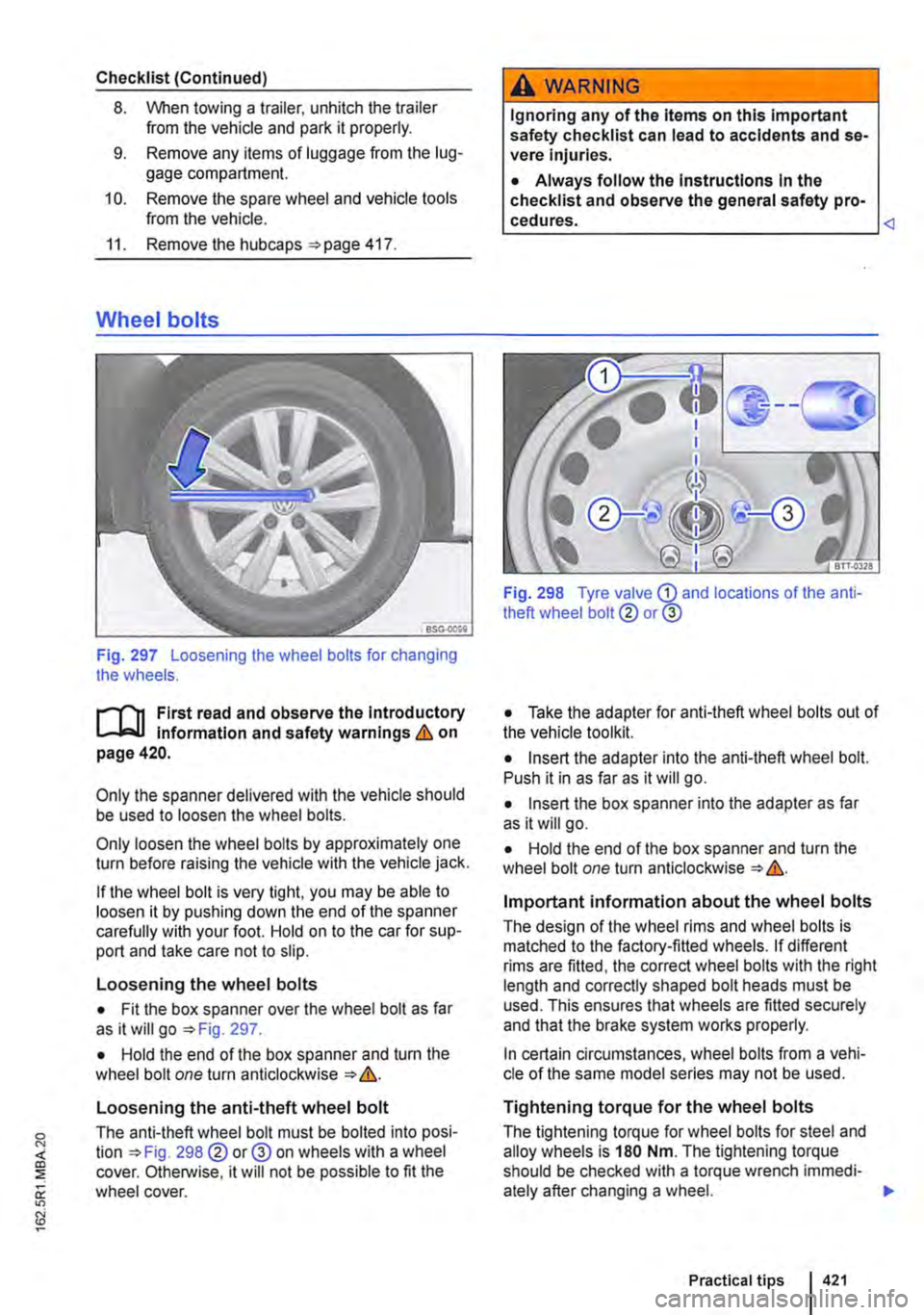
Checklist (Continued)
8. VI/hen towing a trailer, unhitch the trailer from the vehicle and park it properly.
9. Remove any items of luggage from the lug-gage compartment.
10. Remove the spare wheel and vehicle tools from the vehicle.
11. Remove the hubcaps =>page 417.
Wheel bolts
Fig. 297 Loosening the wheel bolts for changing the wheels.
r-"f"'n First read and observe the Introductory l.-J,:..LJ Information and safety warnings & on page420.
Only the spanner delivered with the vehicle should be used to loosen the wheel bolts.
Only loosen the wheel bolts by approximately one turn before raising the vehicle with the vehicle jack.
If the wheel bolt is very tight, you may be able to loosen it by pushing down the end of the spanner carefully with your foot. Hold on to the car for sup-port and take care not to slip.
Loosening the wheel bolts
• Fit the box spanner over the wheel bolt as far as it will go =>Fig. 297.
• Hold the end of the box spanner and turn the wheel bolt one turn anticlockwise => &.
Loosening the anti-theft wheel bolt
The anti-theft wheel bolt must be bolted into posi-tion =>Fig. 298@ or@ on wheels with a wheel cover. Otherwise, it will not be possible to fit the wheel cover.
A WARNING
Ignoring any of the Items on this Important safety checklist can lead to accidents and se-vere Injuries.
• Always follow the Instructions In the checklist and observe the general safety pro-
Fig. 298 Tyre valve G) and locations of the anti-theft wheel bolt@ or@
• Take the adapter for anti-theft wheel bolts out of the vehicle toolkit.
• Insert the adapter into the anti-theft wheel bolt. Push it in as far as it will go.
• Insert the box spanner into the adapter as far as it will go.
• Hold the end of the box spanner and turn the wheel bolt one turn anticlockwise => &.
Important information about the wheel bolts
The design of the wheel rims and wheel bolts is matched to the factory-fitted wheels. If different rims are fitted, the correct wheel bolts with the right length and correctly shaped bolt heads must be used. This ensures that wheels are fitted securely and that the brake system works properly.
In certain circumstances, wheel bolts from a vehi-cle of the same model series may not be used.
Tightening torque for the wheel bolts
The tightening torque for wheel bolts for steel and alloy wheels is 180 Nm. The tightening torque should be checked with a torque wrench immedi-ately after changing a wheel. .,.
Practical tips 421
Page 422 of 486
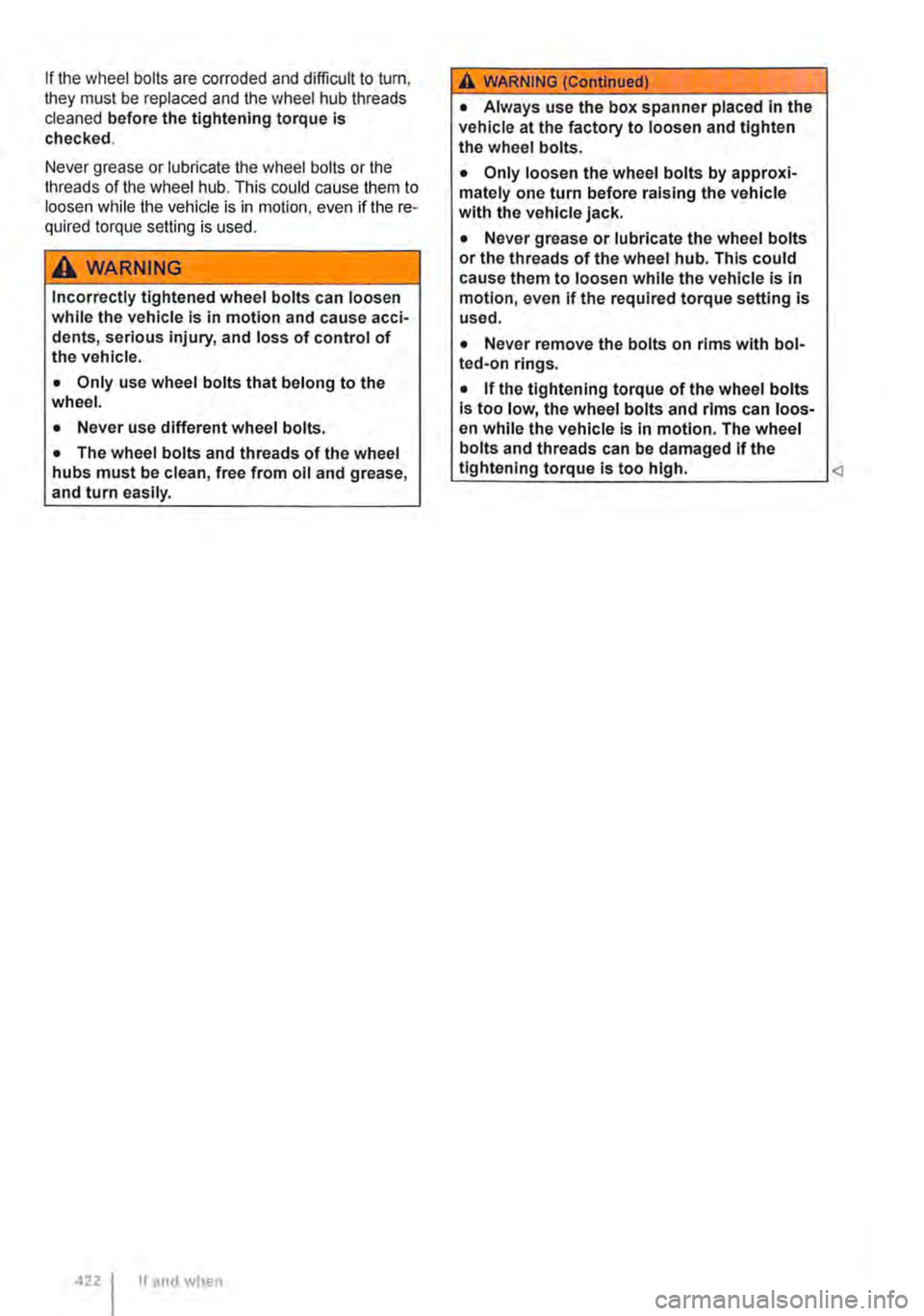
If the wheel boils are corroded and difficult to turn, they must be replaced and the wheel hub threads cleaned before the tightening torque is checked.
Never grease or lubricate the wheel bolts or the threads of the wheel hub. This could cause them to loosen while the vehicle is in motion, even if the re-quired torque setting is used.
A WARNING
Incorrectly tightened wheel bolts can loosen while the vehicle is in motion and cause acci-dents, serious injury, and loss of control of the vehicle.
• Only use wheel bolts that belong to the wheel.
• Never use different wheel bolts.
• The wheel bolts and threads of the wheel hubs must be clean, free from oil and grease, and turn easily.
4221 If and when
A WARNING (Continued)
• Always use the box spanner placed In the vehicle at the factory to loosen and tighten the wheel bolts.
• Only loosen the wheel bolts by approxi-mately one turn before raising the vehicle with the vehicle jack.
• Never grease or lubricate the wheel bolts or the threads of the wheel hub. This could cause them to loosen while the vehicle is in motion, even if the required torque setting is used.
• Never remove the bolts on rims with bol-ted-on rings.
• If the tightening torque of the wheel bolts Is too low, the wheel bolts and rims can loos-en while the vehicle is In motion. The wheel bolts and threads can be damaged if the tightening torque is too high.
Page 423 of 486
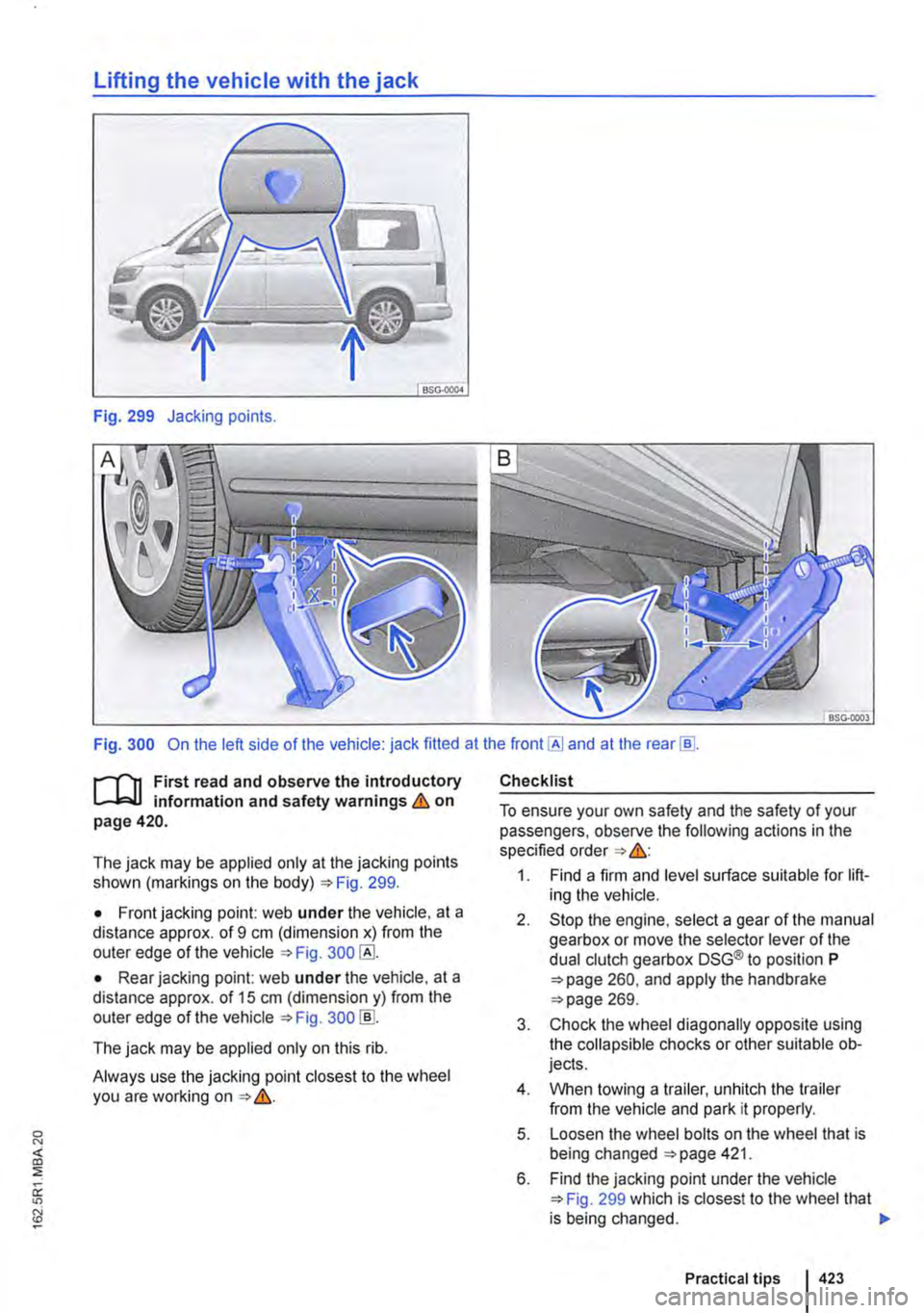
Lifting the vehicle with the jack
Fig. 299 Jacking points.
Fig. 300 On the left side of the vehicle: jack fitted at the front [AI and at the rear [ID.
r-('n First read and observe the introductory l.,...Jc.ll information and safety warnings & on page 420.
The jack may be applied only at the jacking points shown (markings on the body) '*Fig. 299.
• Front jacking point: web under the vehicle, at a distance approx. of 9 cm (dimension x) from the outer edge of the vehicle 300
• Rear jacking point: web under the vehicle, at a distance approx. of 15 cm (dimension y) from the outer edge of the vehicle 300 [ID.
The jack may be applied only on this rib.
Always use the jacking point closest to the wheel you are working on &.
Checklist
To ensure your own safety and the safety of your passengers, observe the following actions in the specified order &:
1. Find a firm and level surface suitable for lift-ing the vehicle.
2. Stop the engine, select a gear of the manual gearbox or move the selector lever of the dual clutch gearbox DSG® to position P '*page 260, and apply the handbrake 269.
3. Chock the wheel diagonally opposite using the collapsible chocks or other suitable ob-jects.
4. When towing a trailer, unhitch the trailer from the vehicle and park it properly.
5. Loosen the wheel bolts on the wheel that is being changed 421.
6. Find the jacking point under the vehicle '*Fig. 299 which is closest to the wheel that is being changed. .,.
Practical tips I 423